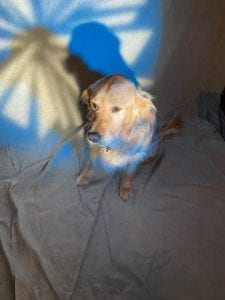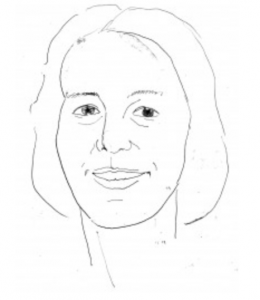TA Spring 2020 Remote Teaching Highlights
Check out all of our awesome Faculty & GEs who are tackling this term of remote teaching!
Janet Rose builds a Light Lab in her garage for TA 467- Lighting for the Stage
With her trusty teaching assistant, golden retriever Sam Rose, Janet highlights some blocking techniques in her garage light lab:

TA 212 Recognized by the Provost for Innovation!
Stitch by Stitch
Kudos to all our amazing TA Faculty & GE members who are making this term of remote education work!
Costume faculty Jeanette deJong’s and GE Mica Pointer’s TA 212 Class has been recognized by the provost for innovation! Mica and Jeanette assembled sewing kits to mail to their students and Mica even set up a Youtube channel to work in conjunction with Jeanette’s Zoom sessions!
Read Jeanette’s interview here about how they conceptualized the class: https://provost.uoregon.edu/virtual-faculty-stories#stitch

Full article transcript:
Theater Arts 212: Stitch by Stitch
Students sew at home in Jeanette deJong’s costume design class.
For some Theater Arts students, the College of Arts and Sciences Theater Production II class is a can that’s been kicked down the road toward graduation, says Jeanette deJong, associate professor of costume design. That’s because of the costume makeup portion of the class.
“I have the men shave, so that their whole face is a palette,” she explains.
One bearded senior in particular was procrastinating whittling down his whiskers, she says. But this term, he lucked out. “I emailed him last night,” deJong recalls. She wrote him: “You’re really lucky you’re not going to have to shave for this. But, you still have to design your whole face.”
Teaching the makeup portion of the class online will be a departure from the norm, but it’s not something deJong can’t handle. She graded winter term finals based on photos students sent her, and she’ll do the same with her spring class.
DeJong uses a self-portrait to create a makeup template for all of students.
They’ll begin the term by photographing their faces without makeup. DeJong will use those images to create a personalized blank template for each student to plan out makeup looks.
When it’s time to paint their faces, students will take their own photos for submission instead of deJong doing it in person under controlled lighting. Now, her best bet for uniformity will be to have students go outside for clearer, brighter light. A few students will be learning from California, but most are here in Eugene, she says. “At least I’ll know what the conditions are here,” she jokes. DeJong even created a makeup template from her own face, as seen in her faculty headshot, that she uses to demonstrate the technique for students.
The first portion of the class focuses on costume production and will begin with hand sewing. DeJong spent spring break assembling 12 sewing kits to mail out for the first week of class. Printed flannel, muslin, a couple of needles, a tiny spool of thread, beeswax, a button, a hook and eye, snaps and a skirt hook went into the first package. She knows students will be able to practice techniques like seams and embroidery.
Many students have expressed concerns about losing access to campus sewing machines, deJong says, noting that “it usually is a very high contact class.”
So instead, deJong will demo sewing techniques over video. Students will be assigned to write detailed instructions of what she’s doing instead of copying her on their own machines. DeJong hopes this exercise will give them a stronger foundation and higher retention.
And, because they’ll spend less time practicing on machines, the class will have a chance to go over other subjects in greater detail, such as hand sewing and fabric types. “Instead of me passing around swatches, I’m going to send them a bunch,” says deJong. “They’ll actually have something in their hands.”
The two-by-two squares she sent include cottons, linens, silks, wools and polyesters, each with its own feel. DeJong will also show them how to safely do a “burn test,” a way to identify material because of the way it burns.
DeJong has worked in costume design around the country for more than three decades, at times on multiple separate productions, so she’s not unused to working at a distance. Communicating through images and using technology to assist with learning is a norm for her.
Despite some changes to her course focus, all the students have been pretty positive going into term, deJong says. That support goes both ways.
“I think the students are going to help us out a lot, to be honest,” she says. “I think they’ll pull along with us.

